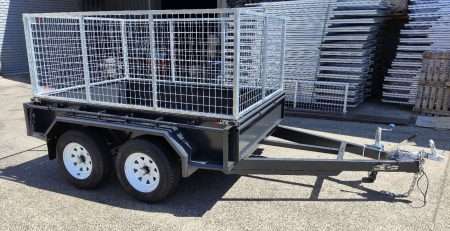
Enhance Your Vehicles Towing Capability with Top-Notch Hitch Receivers
Understanding Hitch Receivers
Before delving into the various components and intricacies of hitch receivers, it’s essential to grasp a basic understanding of what a hitch receiver is and the different types available on the market.
Basics of Hitch Receivers
A hitch receiver is a device that is mounted onto the frame of a vehicle, allowing it to tow a trailer or other towable equipment. It consists of a square or rectangular opening, known as a receiver tube, designed to accept a trailer hitch. This device provides a secure connection point for towing trailers or other heavy loads, enhancing your vehicle’s utility and versatility.
Different Types of Hitch Receivers
Hitch receivers are categorised into different types based on the maximum weight they can tow and the class of vehicle they’re suitable for. Understanding these types is crucial for selecting the most appropriate hitch receiver for your vehicle and towing needs.
- Rear Receiver Hitches: The most common type of hitch, rear receiver hitches, are mounted to the frame of the vehicle at the rear. They are versatile and can be used with various hitch-mounted accessories, including bike racks and cargo carriers.
- Front Mount Hitches: These hitches are installed at the front of the vehicle. They are typically used for mounting accessories like bike racks, spare tyres, and even a snowplow.
- 5th Wheel Hitches: Designed for heavy-duty towing, 5th wheel hitches are used for towing large trailers. They are mounted in the bed of a pickup truck and offer superior handling and stability.
- Gooseneck Hitches: Similar to 5th wheel hitches, gooseneck hitches are used for heavy-duty towing. They are installed in the bed of a pickup truck and are ideal for towing large trailers, including horse and livestock trailers.
- Pintle Hitches: These hitches are typically used in heavy-duty applications, including commercial and industrial settings. They consist of a hook (pintle) and a lunette ring, providing a secure connection for towing heavy loads.
Choosing the right hitch receiver type depends on your vehicle and towing requirements. It’s also crucial to consider other towing accessories like a trailer brake controller, trailer hitch lock, and trailer wiring harness to ensure safe and efficient towing.
Components of Hitch Receivers
A hitch receiver, a device mounted to the frame of a vehicle, allows for the towing of a trailer or other towable equipment. The primary components of a hitch receiver are the hitch receiver tube and the hitch receiver pin.
Hitch Receiver Tubes
A hitch receiver tube is a metal tube that mounts to the vehicle’s frame. It is used to attach hitch-mounted accessories, such as a ball mount. Hitch receiver tubes are available in a variety of sizes and styles to accommodate different types of hitch-mounted accessories.
Hitch receivers are available in various sizes, including 1-1/4″, 2″, 2-1/2″ and 3″ receiver openings, to fit different types of trailers and towing loads (CURT Manufacturing). The size of the receiver opening is designed to fit a specific type of hitch ball mount, such as a fixed ball mount, adjustable ball mount, or weight distribution hitch.
| Receiver Tube Size | Suitable For |
|---|---|
| 1-1/4″ | Light-duty towing (bike racks, cargo carriers) |
| 2″ | Medium-duty towing (small trailers, boats) |
| 2-1/2″ | Heavy-duty towing (large trailers, campers) |
| 3″ | Extra heavy-duty towing (large boats, fifth-wheel trailers) |
Hitch Receiver Pins
A hitch receiver pin is an essential component that holds the hitch receiver in place. It goes through the holes on the side of the receiver tube, ensuring the hitch receiver stays securely attached to the vehicle during towing (fastway trailer).
To enhance the security of your hitch receiver and prevent theft, consider using a trailer hitch lock. These locks work similarly to hitch pins but include a locking mechanism that requires a key to be removed.
Understanding the components of a hitch receiver is crucial for safe and successful towing. Ensure to select the right size of receiver tube for your towing needs and always secure the hitch receiver with a sturdy hitch pin or lock. For more information on hitch receivers and other towing accessories, check out our guides on trailer brake controllers, electric winches, and trailer light kits.
Hitch Receiver Classes
Understanding the classification system of hitch receivers is crucial for making an informed decision about the right fit for your towing needs. Hitch receivers come in different classes, including Class 1 to Class 5, each with its own weight capacity. These classes can be broadly divided into two categories for convenience.
Class 1 to Class 2 Hitch Receivers
Class 1 and Class 2 hitch receivers are suitable for lighter towing tasks. They are typically installed on smaller vehicles, like cars and small SUVs, due to their lower weight capacities.
For instance, Class 1 hitch receivers have a maximum tongue weight capacity (weight that the trailer puts on the hitch itself) of 200 lbs and a maximum gross trailer weight capacity (total weight of the trailer and its cargo) of 2,000 lbs.
| Class | Maximum Tongue Weight Capacity (lbs) | Maximum Gross Trailer Weight Capacity (lbs) |
|---|---|---|
| Class 1 | 200 | 2,000 |
| Class 2 | 300 | 3,500 |
These classes of hitch receivers are ideal for light-duty towing tasks such as pulling small trailers, bike racks, or cargo carriers.
Class 3 to Class 5 Hitch Receivers
Class 3 to Class 5 hitch receivers are designed for medium- to heavy-duty towing tasks. They are typically installed on larger vehicles like pickup trucks, SUVs, and vans due to their higher weight capacities.
| Class | Maximum Tongue Weight Capacity (lbs) | Maximum Gross Trailer Weight Capacity (lbs) |
|---|---|---|
| Class 3 | 800 | 8,000 |
| Class 4 | 1,000 | 10,000 |
| Class 5 | 1,200 | 12,000 |
These hitch receiver classes are suitable for towing larger trailers, boats, and campers, as well as carrying heavy-duty cargo carriers and bike racks.
When selecting a hitch receiver, it’s important to ensure that the weight capacity of the hitch matches the weight of the trailer and the towing capacity of the vehicle. Overloading can lead to hitch failure and may pose serious safety risks.
For more information on towing safety and hitch receiver maintenance, refer to our articles on towing safety measures and protecting hitch receivers.
Hitch Receiver Installation
Installing a hitch receiver on your vehicle is a process that requires careful preparation and adherence to specific steps. The installation process varies depending on the type of vehicle and the specific hitch receiver being installed. However, general guidelines can be followed to ensure a successful installation.
Preparing for Installation
Before starting the installation process, it’s crucial to gather the appropriate tools and equipment. Additionally, it’s important to thoroughly read the manufacturer’s instructions that come with the hitch receiver. These instructions will provide specific details about the installation process and any special requirements (Curt Manufacturing).
Hitch receivers can be installed on various types of vehicles, including cars, trucks, SUVs, and vans. However, consider the towing capacity of the vehicle when selecting a hitch receiver (Curt Manufacturing). This information can often be found in the vehicle’s owner’s manual or from the vehicle manufacturer.
Installation Process
The installation process begins by positioning the hitch receiver in the correct location on the vehicle. This typically involves aligning the hitch receiver with the frame of the vehicle. Ensure the hitch receiver is secure and level before proceeding.
Next, the hitch receiver is attached to the vehicle using the provided hardware. This usually involves bolting the hitch receiver to the vehicle’s frame. It’s crucial to tighten all bolts securely to ensure that the hitch receiver is firmly attached to the vehicle.
Once the hitch receiver is securely attached, any additional components, such as wiring for a trailer wiring harness or a trailer brake controller, can be installed.
After the hitch receiver and any additional components are installed, it’s important to check all connections and ensure that everything is secure. This includes checking the tightness of all bolts and verifying that the hitch receiver is level.
Finally, be sure to follow any specific instructions provided by the manufacturer for finalising the installation. This may include steps such as applying a corrosion-resistant finish to protect the hitch receiver from rust and other damage (Curt Manufacturing).
In conclusion, installing a hitch receiver requires careful preparation and attention to detail. By following the manufacturer’s instructions and using the appropriate tools and equipment, you can successfully enhance your vehicle’s towing capability.
Selecting the Right Hitch Receiver
Choosing the right hitch receiver for your vehicle is a crucial task. The proper hitch receiver ensures that you can safely and effectively tow trailers, boats, or other loads.
Factors to consider
When selecting a hitch receiver, there are several factors to consider. The foremost consideration is the towing capacity of your vehicle and the weight of the load you will be towing (CURT Manufacturing).
You need to ensure that the hitch receiver you choose is capable of managing the weight of your trailer, boat, or other equipment safely. Hitch receivers come in different classes, each with their own weight capacities and towing capabilities.
The hitch receiver class you select must correspond with the type and weight of your load. For example, Class 1 and Class 2 hitch receivers are designed for smaller loads, while Class 3, Class 4, and Class 5 hitch receivers are designed for larger loads (CURT Manufacturing).
Another important aspect to consider is the specific type of trailer or load you will be towing. Different types of loads may require different hitch receivers.
Furthermore, the hitch receiver you choose should be compatible with other towing accessories you might use, such as a trailer brake controller, trailer hitch lock, or trailer wiring harness.
Vehicle Compatibility
The compatibility of the hitch receiver with your vehicle is another crucial factor to consider. Not all hitch receivers are suitable for all types of vehicles.
For example, Class 1 and Class 2 hitch receivers are generally suitable for compact cars and small SUVs. On the other hand, Class 3, Class 4, and Class 5 hitch receivers are more suitable for full-size trucks and SUVs, which have higher towing capacities (CURT Manufacturing).
| Hitch Receiver Class | Suitable Vehicles | Weight Capacity (lbs) | Tongue weight (lbs) |
|---|---|---|---|
| Class 1-Class 2 | Compact cars and small SUVs | 2,000–3,500 | Up to 350 |
| Class 3-Class 5 | Full-size trucks and SUVs | 3,500–20,000 | Up to 2,700 |
To verify compatibility, you can check the vehicle owner’s manual or consult with the hitch receiver manufacturer or a professional installer.
Choosing a hitch receiver that is compatible with your vehicle and meets your specific towing needs will ensure a safe, effective, and hassle-free towing experience.
Hitch Receiver Maintenance and Safety
Maintaining your hitch receiver and adhering to safety measures are crucial when you’re towing trailers or other heavy loads. In this section, we’ll provide guidance on how to protect your hitch receiver and ensure safety while towing.
Protecting Hitch Receivers
Hitch receivers are typically made of strong and durable materials like steel, which ensures they can withstand the stresses of towing heavy loads. However, to prolong their lives and maintain their performance, it’s important to protect them from potential damage and corrosion.
One of the best ways to protect your hitch receiver is to use a trailer hitch lock. This device not only secures your trailer but also protects the hitch receiver from dirt, rust, and other elements.
Hitch receivers are often coated with a protective finish, such as powder coating or zinc plating, to enhance their durability and resistance to corrosion. It’s essential to check the coating regularly and reapply it as needed to prevent rust and degradation.
Towing Safety Measures
Safety is paramount when towing. When selecting a hitch receiver, it’s crucial to consider the towing capacity of your vehicle as well as the specific weight and type of trailer or load you’ll be towing (Weigh-Safe). Overloading your hitch receiver or towing with an improper setup can lead to accidents and damage to your vehicle.
Here are a few safety measures to bear in mind when towing:
- Always use safety chains. They provide an extra line of defence in case your main connection fails.
- Equip your trailer with a trailer brake controller if it’s heavy. This device allows you to control the trailer’s brakes from your vehicle, improving stopping power and control.
- Ensure your trailer’s lights are working properly. You may need to install a trailer wiring harness or a trailer light kit to connect your trailer’s lights to your vehicle.
- Regularly check and maintain your trailer winch, electric winch, atv winch, or boat trailer winch to ensure they’re in good working order.
By following these maintenance and safety tips, you can ensure that your hitch receiver remains in top-notch condition for safe and efficient towing.
Author
I am Rahatul Ashiq Tamal. Another author of Muscle Trailers. Muscle Trailers is a well-known trailer brand in Sydney, Melbourne & Adelaide

How to Mount a Spare Tire on Your Trailer: A Simple Step-by-Step Guide
Trailer service centers receive over 1 million phone calls and 1.3 million emails each year about trailer maintenance problems....

How to Fix RV Roof Leaks: Simple Roof Leak Detection Guide for Beginners
Did you know DIY RV roof repairs can cost under $50? But undetected leaks could lead to substantially higher repair...

Starting a Food Truck Business in Australia: From Trailer Selection to Launch
The Australian mobile food market has evolved into a billion-dollar industry. This makes a food truck...
